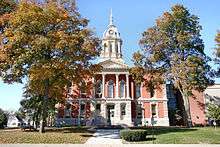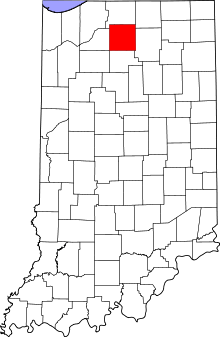Marshall County, Indiana
| Marshall County, Indiana | |
|---|---|
 Marshall County courthouse in Plymouth, Indiana | |
 Location in the state of Indiana | |
 Indiana's location in the U.S. | |
| Founded | 1836 |
| Named for | John Marshall |
| Seat | Plymouth |
| Largest city | Plymouth |
| Area | |
| • Total | 449.74 sq mi (1,165 km2) |
| • Land | 443.63 sq mi (1,149 km2) |
| • Water | 6.11 sq mi (16 km2), 1.36% |
| Population | |
| • (2010) | 47,051 |
| • Density | 106/sq mi (40.88/km²) |
| Congressional district | 2nd |
| Time zone | Eastern: UTC-5/-4 |
| Website |
www |
| Footnotes: Indiana county number 50 | |
Marshall County is a county located in the U.S. state of Indiana. Census 2010 recorded the population at 47,051.[1] The county seat is Plymouth.[2]
History
Marshall County was formed in 1836, during the early years of European-American settlement and before the forced removal of the Potawatomi people in 1838. It was named for U.S. Chief Justice John Marshall, who died in 1835.[3] Marshall County is notable as the starting point in 1838 of the Potawatomi Trail of Death, which was the forced removal by United States forces of Chief Menominee and 859 members of the Potawatomi nation from Indiana to Indian Territory, at the site of present-day Osawatomie, Kansas, a distance of 660 miles (1,060 km). The first non-Native American settlers arrived in what is now Marshall County in 1835. They arrived as a result of the end of the Black Hawk War as well as the completion of the Erie Canal. They consisted primarily of settlers from New England, "Yankees" descended from the English Puritans who settled New England in the colonial era. They were mainly members of the Congregational Church, although due to the Second Great Awakening many of them had converted to Methodism and some had become Baptists before coming to what is now Marshall County. As a result of this heritage, some place names in Marshall County are named after places in New England, such as Plymouth, which is named after Plymouth, Massachusetts, the site where the Mayflower landed in 1620.[4] Some German families came at the same time, settling mainly in what became German township. When these settlers arrived, there was nothing but a dense virgin forest and wild marshland, which would need to be cleared and drained before it could be farmed.
Geography
According to the 2010 census, the county has a total area of 449.74 square miles (1,164.8 km2), of which 443.63 square miles (1,149.0 km2) (or 98.64%) is land and 6.11 square miles (15.8 km2) (or 1.36%) is water.[5] The Yellow River flows through northern, central, and western portions of Marshall County, past Plymouth; the Tippecanoe River flows through the southeastern part of the county.[6]
Adjacent counties
- St. Joseph County (north)
- Elkhart County (northeast)
- Kosciusko County (east)
- Fulton County (south)
- Pulaski County (southwest)
- Starke County (west/CST Border)
Major highways
Cities and towns
Census-designated place
Townships
Climate and weather
| Plymouth, Indiana | ||||||||||||||||||||||||||||||||||||||||||||||||||||||||||||
|---|---|---|---|---|---|---|---|---|---|---|---|---|---|---|---|---|---|---|---|---|---|---|---|---|---|---|---|---|---|---|---|---|---|---|---|---|---|---|---|---|---|---|---|---|---|---|---|---|---|---|---|---|---|---|---|---|---|---|---|---|
| Climate chart (explanation) | ||||||||||||||||||||||||||||||||||||||||||||||||||||||||||||
| ||||||||||||||||||||||||||||||||||||||||||||||||||||||||||||
| ||||||||||||||||||||||||||||||||||||||||||||||||||||||||||||
In recent years, average temperatures in Plymouth have ranged from a low of 16 °F (−9 °C) in January to a high of 86 °F (30 °C) in July, although a record low of −25 °F (−32 °C) was recorded in January 1985 and a record high of 109 °F (43 °C) was recorded in July 1936. Average monthly precipitation ranged from 1.86 inches (47 mm) in February to 4.48 inches (114 mm) in June.[7]
Government
The county government is a constitutional body, and is granted specific powers by the Constitution of Indiana, and by the Indiana Code.
County council: The county council is the legislative branch of the county government and controls all the spending and revenue collection in the county. Representatives are elected from county districts. The council members serve four-year terms. They are responsible for setting salaries, the annual budget, and special spending. The council also has limited authority to impose local taxes, in the form of an income and property tax that is subject to state level approval, excise taxes, and service taxes.[8][9]
Board of commissioners: The executive body of the county is made of a board of commissioners. The commissioners are elected county-wide, in staggered terms, and each serves a four-year term. One of the commissioners, typically the most senior, serves as president. The commissioners are charged with executing the acts legislated by the council, collecting revenue, and managing the day-to-day functions of the county government.[8][9]
Current commissioners: Kurt Garner, Deb Griewank, Kevin Overmyer
Court: The county maintains a small claims court that can handle some civil cases. The judge on the court is elected to a term of four years and must be a member of the Indiana Bar Association. The judge is assisted by a constable who is also elected to a four-year term. In some cases, court decisions can be appealed to the state level circuit court.[9]
County Officials: The county has several other elected offices, including sheriff, coroner, auditor, treasurer, recorder, surveyor, and circuit court clerk Each of these elected officers serves a term of four years and oversees a different part of county government. Members elected to county government positions are required to declare party affiliations and to be residents of the county.[9]
Marshall County is part of Indiana's 2nd congressional district and in 2008 was represented by Joe Donnelly in the United States Congress.[10] It is also part of Indiana Senate districts 5 and 9[11] and Indiana House of Representatives districts 17 and 23.[12]
Demographics
| Historical population | |||
|---|---|---|---|
| Census | Pop. | %± | |
| 1840 | 1,651 | — | |
| 1850 | 5,348 | 223.9% | |
| 1860 | 12,722 | 137.9% | |
| 1870 | 20,211 | 58.9% | |
| 1880 | 23,414 | 15.8% | |
| 1890 | 23,818 | 1.7% | |
| 1900 | 25,119 | 5.5% | |
| 1910 | 24,175 | −3.8% | |
| 1920 | 23,744 | −1.8% | |
| 1930 | 25,077 | 5.6% | |
| 1940 | 25,935 | 3.4% | |
| 1950 | 29,468 | 13.6% | |
| 1960 | 32,443 | 10.1% | |
| 1970 | 34,986 | 7.8% | |
| 1980 | 39,155 | 11.9% | |
| 1990 | 42,182 | 7.7% | |
| 2000 | 45,128 | 7.0% | |
| 2010 | 47,051 | 4.3% | |
| Est. 2014 | 47,107 | [13] | 0.1% |
| U.S. Decennial Census[14] 1790-1960[15] 1900-1990[16] 1990-2000[17] 2010-2013[1] | |||
As of the 2010 United States Census, there were 47,051 people, 17,406 households, and 12,516 families residing in the county.[18] The population density was 106.1 inhabitants per square mile (41.0/km2). There were 19,845 housing units at an average density of 44.7 per square mile (17.3/km2).[5] The racial makeup of the county was 93.5% white, 0.5% black or African American, 0.5% Asian, 0.2% American Indian, 3.8% from other races, and 1.5% from two or more races. Those of Hispanic or Latino origin made up 8.4% of the population.[18] In terms of ancestry, 35.4% were German, 11.2% were Irish, 9.4% were American, and 8.5% were English.[19]
Of the 17,406 households, 35.2% had children under the age of 18 living with them, 57.2% were married couples living together, 9.9% had a female householder with no husband present, 28.1% were non-families, and 24.1% of all households were made up of individuals. The average household size was 2.66 and the average family size was 3.15. The median age was 38.4 years.[18]
The median income for a household in the county was $47,697 and the median income for a family was $58,017. Males had a median income of $43,732 versus $30,033 for females. The per capita income for the county was $22,493. About 8.7% of families and 12.2% of the population were below the poverty line, including 17.1% of those under age 18 and 10.4% of those age 65 or over.[20]
See also
References
- 1 2 "Marshall County QuickFacts". United States Census Bureau. Retrieved 2011-09-25.
- ↑ "Find a County". National Association of Counties. Retrieved 2011-06-07.
- ↑ De Witt Clinton Goodrich & Charles Richard Tuttle (1875). An Illustrated History of the State of Indiana. Indiana: R. S. Peale & co. p. 567.
- ↑ A Twentieth Century History of Marshall County, Indiana, Volume 1 By Daniel McDonald
- 1 2 "Population, Housing Units, Area, and Density: 2010 - County". United States Census Bureau. Retrieved 2015-07-10.
- ↑ Indiana Atlas & Gazetteer. Yarmouth, Me.: DeLorme. 1998. pp. 20–21, 26–27. ISBN 0-89933-211-0.
- 1 2 "Monthly Averages for Plymouth, Indiana". The Weather Channel. Retrieved 2011-01-27.
- 1 2 Indiana Code. "Title 36, Article 2, Section 3". IN.gov. Retrieved 2008-09-16.
- 1 2 3 4 Indiana Code. "Title 2, Article 10, Section 2" (PDF). IN.gov. Retrieved 2008-09-16.
- ↑ "US Congressman Joe Donnelly". US Congress. Retrieved 2008-10-08.
- ↑ "Indiana Senate Districts". State of Indiana. Retrieved 2011-07-14.
- ↑ "Indiana House Districts". State of Indiana. Retrieved 2011-07-14.
- ↑ "Annual Estimates of the Resident Population for Incorporated Places: April 1, 2010 to July 1, 2014". Retrieved June 4, 2015.
- ↑ "U.S. Decennial Census". United States Census Bureau. Retrieved July 10, 2014.
- ↑ "Historical Census Browser". University of Virginia Library. Retrieved July 10, 2014.
- ↑ "Population of Counties by Decennial Census: 1900 to 1990". United States Census Bureau. Retrieved July 10, 2014.
- ↑ "Census 2000 PHC-T-4. Ranking Tables for Counties: 1990 and 2000" (PDF). United States Census Bureau. Retrieved July 10, 2014.
- 1 2 3 "DP-1 Profile of General Population and Housing Characteristics: 2010 Demographic Profile Data". United States Census Bureau. Retrieved 2015-07-10.
- ↑ "DP02 SELECTED SOCIAL CHARACTERISTICS IN THE UNITED STATES – 2006-2010 American Community Survey 5-Year Estimates". United States Census Bureau. Retrieved 2015-07-10.
- ↑ "DP03 SELECTED ECONOMIC CHARACTERISTICS – 2006-2010 American Community Survey 5-Year Estimates". United States Census Bureau. Retrieved 2015-07-10.
 |
St. Joseph County | Elkhart County |  | |
| Starke County | |
Kosciusko County | ||
| ||||
| | ||||
| Pulaski County | Fulton County |
| |||||||||||||||||||||||||||||||||
Coordinates: 41°20′N 86°16′W / 41.33°N 86.26°W